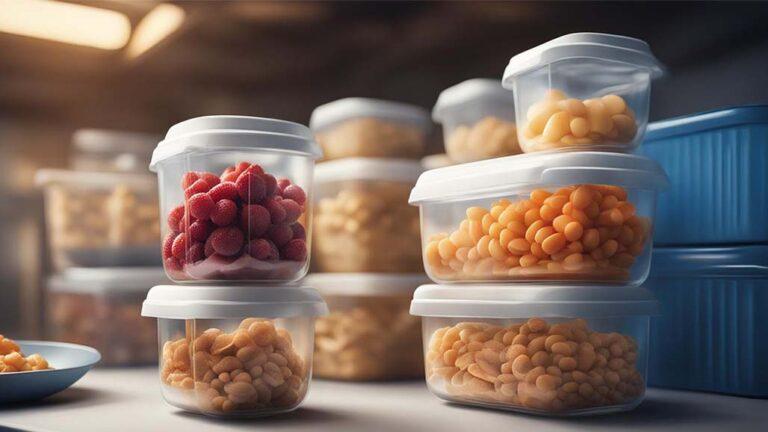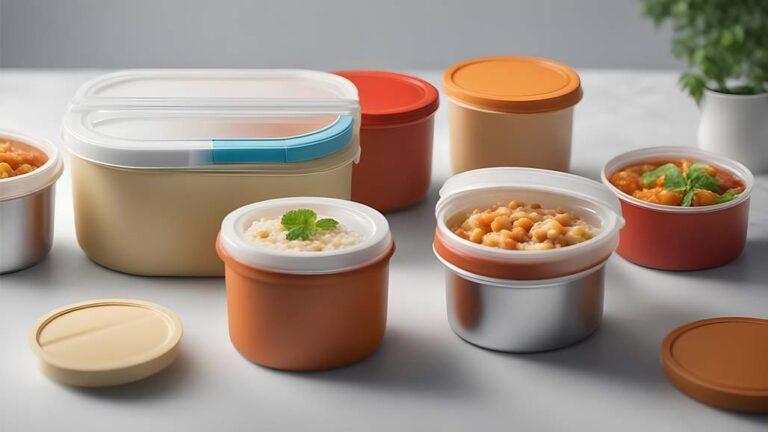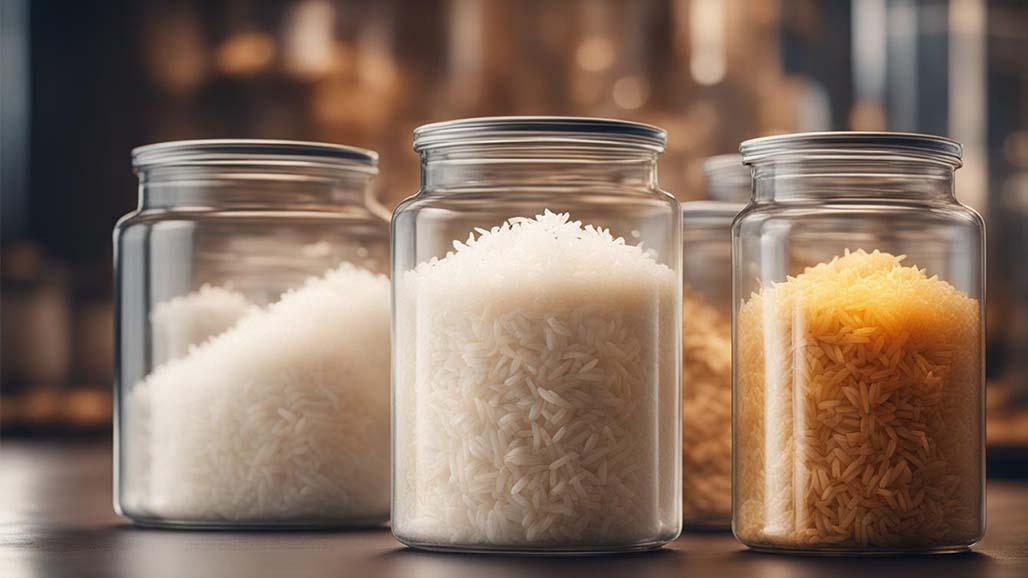
Introduction
What is the best storage container for rice? For millions of people worldwide, rice is a basic diet. Whether you’re a professional chef or a home cook, the way you store your rice can significantly impact its quality, flavor, and shelf life. One of the essential aspects of rice storage is the container you use. In this comprehensive guide, we will explore the various types of rice storage containers available, factors to consider when choosing one container, and the best options on the market. You’ve come to the right place.
Types of what is the best storage container for rice?
When it comes to storing rice, there are several types of containers to choose from, each with its unique features and benefits. Let’s examine the most prevalent types first:
1. Airtight Containers
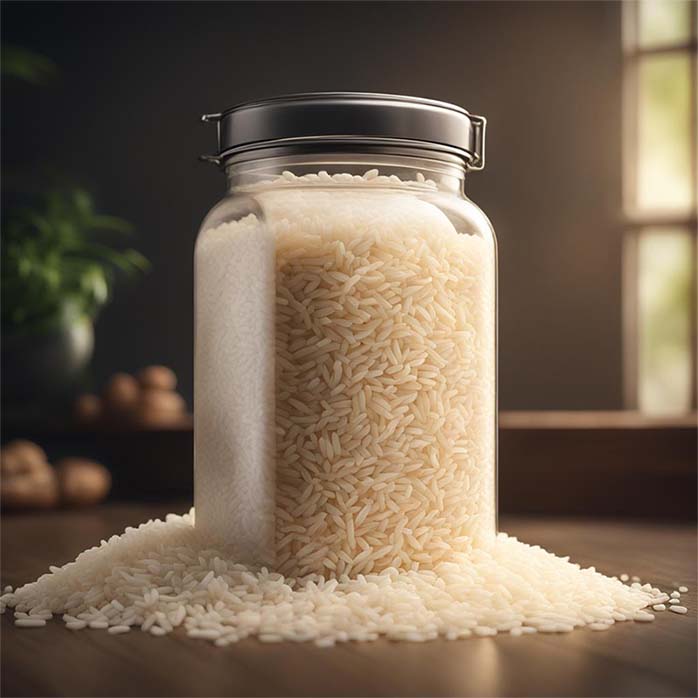
Due to its capacity to produce a sealed environment that keeps pathogens, air, and moisture at bay, airtight containers are a common choice for storing rice. We will examine the benefits and factors of utilizing airtight containers for rice storage in this part.
Advantages of Airtight Containers:
- Preservation of Freshness: Airtight containers are specifically designed to create a sealed, airtight environment. This feature ensures that moisture and oxygen, the two main culprits behind rice spoilage, are kept out. By maintaining a dry and oxygen-free atmosphere, airtight containers help preserve the freshness and quality of your rice over an extended period.
- Protection Against Pests: Airtight seals also act as a barrier against pests such as rice weevils and rice moths. These tiny insects can infiltrate rice, causing contamination and spoilage. Airtight containers effectively prevent such infestations.
- Variety of Sizes: The large selection of sizes available for airtight containers makes it simple to pick one that meets your exact rice storage requirements. There is an airtight solution available whether you need a small container for everyday use or a bigger one for bulk storage.
- Transparency: Clear or translucent materials are found in many airtight containers, allowing you to see the contents without opening the container. The quantity and state of the rice within are easier to check thanks to this transparency.
- Stackability: Airtight containers are often designed with stackable features, enabling efficient use of storage space in your pantry or kitchen cabinets.
Considerations When Using Airtight Containers for Rice Storage:
- Material Selection: Airtight containers can be made from various materials, including plastic, glass, and metal. When choosing an airtight container, consider the material’s durability, transparency, and suitability for your storage environment.
- Inspect Seals: Regularly inspect the seals and gaskets of airtight containers for any signs of wear, damage, or degradation. Damaged seals can compromise the container’s ability to maintain an airtight seal.
- Avoid Extreme Temperatures: Extreme temperature fluctuations can affect the performance of airtight container seals over time. Store your containers in a cool, dry place away from direct sunlight or heat sources.
- Maintenance: Proper maintenance is key to the longevity of airtight containers. Clean and dry the seals and container rims regularly to prevent the buildup of debris or residue that can interfere with the airtight seal.
Tips for Using Airtight Containers for Rice Storage:
- Choose the Right Size: Select an airtight container that matches your rice storage requirements. Smaller containers are ideal for daily use, while larger ones are suitable for storing bulk quantities.
- Label Containers: To easily identify different types of rice or track the purchase date, label your airtight containers. Proper labeling helps maintain organization and ensures you use rice promptly.
- Regular Inspection: Routinely check the seals and gaskets of your airtight containers to ensure they are intact and functioning correctly. Replace damaged seals promptly.
- Proper Sealing: Ensure that the lid is securely sealed each time you close the container. This step is crucial for maintaining an airtight environment.
- Keep Containers Clean: Periodically clean both the interior and exterior of your airtight containers to prevent the accumulation of dirt or food residues.
2. Glass Containers
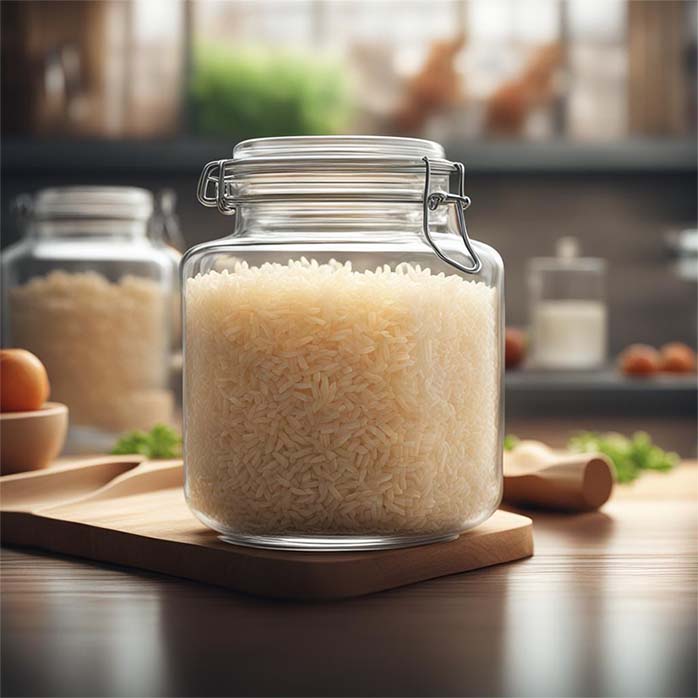
Glass containers offer a unique and transparent solution for storing rice, providing several advantages that make them a popular choice among those seeking to preserve the freshness and quality of their grains. In this section, we will explore the benefits and considerations of using glass containers for rice storage.
Advantages of Glass Containers:
- Visibility: One of the standout features of glass containers is their transparency. This allows you to see the contents clearly without having to open the container. This visual accessibility makes it easy to monitor the quantity, condition, and any potential contaminants in your stored rice.
- Non-Porous Material: Glass is non-porous and impermeable, which means it won’t absorb odors, flavors, or colors from the rice or other foods stored in the container. This feature helps maintain the pure flavor and aroma of your rice.
- Durability: High-quality glass containers are resistant to staining, scratching, and warping. They are also less likely to deteriorate over time compared to some plastic containers.
- Airtight Seals: Many glass containers come with airtight seals or silicone gaskets that create a secure barrier against moisture, air, and contaminants. This airtight quality is essential for preserving the freshness of rice.
- Environmentally Friendly: Glass is a recyclable and sustainable material, making it an eco-conscious choice for those concerned about their environmental footprint.
Considerations When Using Glass Containers for Rice Storage:
- Weight: Glass containers can be heavier than their plastic counterparts, which can make them less convenient to handle, especially when they are filled with rice.
- Fragility: Glass containers are breakable, and dropping them can lead to shattering. In order to avoid mishaps, it’s essential to handle them carefully.
- Cost: Quality glass containers may be more expensive than plastic alternatives, but their durability and longevity can make them a wise investment in the long run.
- Lid Sealing: Inspect the sealing mechanism of the lid regularly to ensure it maintains an airtight seal. Damaged or worn-out seals can compromise the container’s ability to keep rice fresh.
Tips for Using Glass Containers for Rice Storage:
- Select Appropriate Sizes: Choose glass containers that match your rice storage needs, whether it’s for daily use or bulk storage.
- Label Containers: To easily identify different types of rice or keep track of purchase dates, label your glass containers. This will help you maintain organization and use rice promptly.
- Careful Handling: Handle glass containers with care to avoid accidental drops and breakage.
- Regular Inspection: Periodically inspect the lids and seals to ensure they are in good condition and capable of maintaining an airtight environment.
- Clean Properly: Clean both the interior and exterior of your glass containers regularly to prevent the buildup of dirt, residue, or odors.
3. Metal Containers
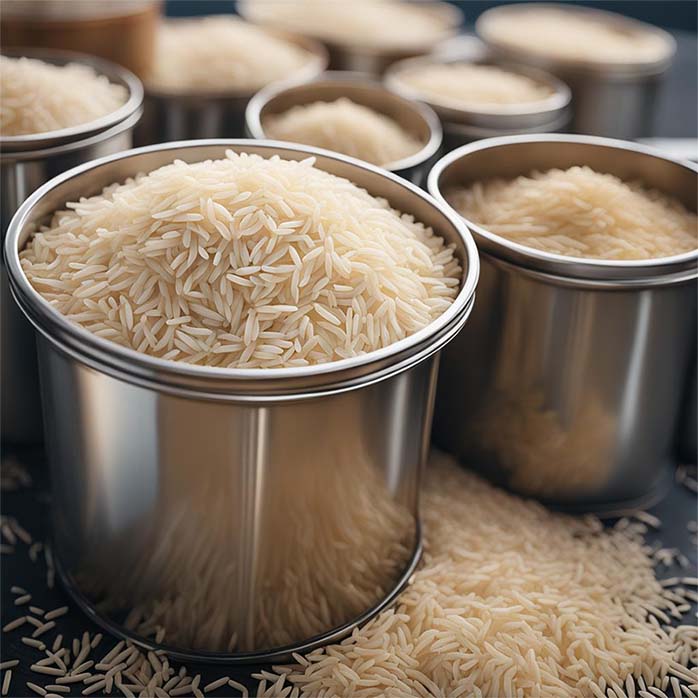
Metal containers offer a durable and reliable option for storing rice, with several advantages that make them a preferred choice among those seeking long-term storage solutions. In this section, we will explore the benefits and considerations of using metal containers for rice storage.
Advantages of Metal Containers:
- Durability: Exceptional durability and resistance to wear and tear are two qualities associated with metal containers. Compared to some other materials, they have a lower propensity to crack, break, or degrade over time.
- Pest Defense: Metal containers offer a powerful defense against pests like rice weevils and rice moths. Their sturdy design keeps bugs out and keeps your rice from becoming contaminated.
- Airtight Seals: Many metal containers come with airtight seals or gaskets that create a secure barrier against moisture, air, and contaminants. This airtight quality is crucial for preserving the freshness of rice, especially during long-term storage.
- Resistance to Odors: Metal containers are non-porous and do not absorb odors from the stored rice or other foods. This feature helps maintain the pure flavor and aroma of your rice.
- Longevity: When properly cared for, metal containers can last for many years, making them a cost-effective choice in the long run.
Considerations When Using Metal Containers for Rice Storage:
- Weight: Metal containers can be heavier than plastic or glass containers, which can make them less convenient to handle, especially when they are filled with rice.
- Cost: Quality metal containers may have a higher initial cost compared to some plastic alternatives, but their durability and longevity can justify the investment.
- Maintenance: Regularly inspect the sealing mechanism of the lid to ensure it maintains an airtight seal. Damaged or worn-out seals can compromise the container’s ability to keep rice fresh.
- Metal Type: Be mindful of the type of metal used in the container. Stainless steel and aluminum are commonly used due to their corrosion resistance, but it’s essential to verify that they are food-safe materials.
Tips for Using Metal Containers for Rice Storage:
- Select Appropriate Sizes: Choose metal containers that match your rice storage needs, whether it’s for daily use or bulk storage.
- Label Containers: To easily identify different types of rice or keep track of purchase dates, label your metal containers. This will help you maintain organization and use rice on time.
- Handle with Care: Metal containers may have sharp edges or corners, so handle them with care to avoid injury.
- Regular Inspection: Periodically inspect the lids and seals to ensure they are in good condition and capable of maintaining an airtight environment.
- Clean Properly: Clean both the interior and exterior of your metal containers regularly to prevent the buildup of dirt, residue, or odors.
4. Plastic Containers
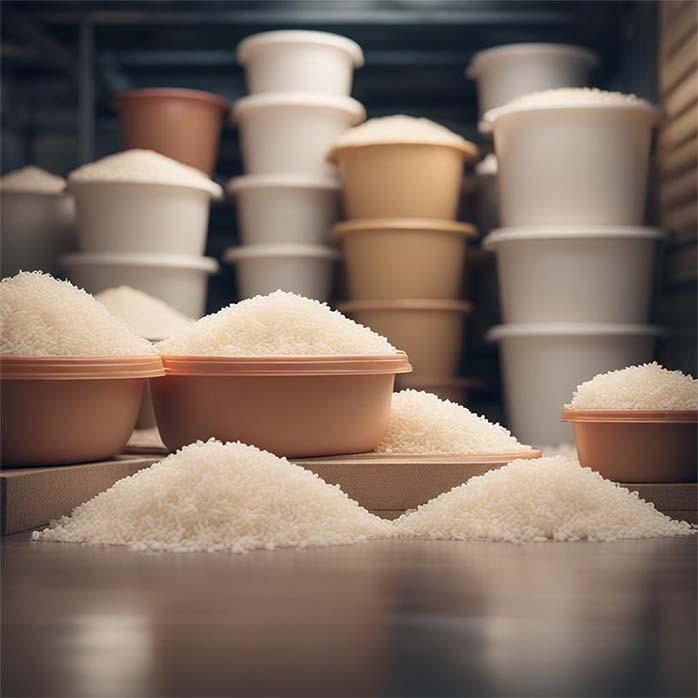
Plastic storage containers are among the most useful and adaptable choices for holding rice. Plastic containers are available in a variety of forms, dimensions, and styles, making them ideal for a range of storage requirements. We will look at the benefits and issues of utilizing plastic storage containers for rice in this section.
Advantages of Plastic Containers:
- Cost-effectiveness: Plastic containers are frequently less expensive than those made of materials like glass or ceramic. They are thus a viable option for homes of all income brackets.
- Variety: Plastic containers come in a wide range of sizes, from little ones that are perfect for daily use to enormous ones that are ideal for bulk storage. You can choose the size that best suits your needs thanks to the variety.
- Plastic containers are lightweight and manageable, making them practical for daily usage. If you frequently use rice and require a portable container, this function is extremely helpful.
- Airtight Options: Many plastic containers come equipped with airtight seals or Snap-On lids, which are crucial for maintaining the freshness and quality of rice. The airtight seal prevents moisture, air, and contaminants from affecting the rice inside.
- Transparency: Some plastic containers are clear or translucent, making it possible to view what’s within without opening the package. It is simple to check the amount and quality of the rice within due to the transparency.
- Stackability: Plastic containers are often designed with stackable features, enabling efficient use of storage space in your pantry or kitchen cabinets.
Considerations When Using Plastic Containers for Rice Storage:
- Material Quality: While plastic containers are generally durable, it’s essential to choose containers made from food-grade, BPA-free plastic to ensure that they are safe for storing food items like rice.
- Avoid Sunlight: Placing plastic containers in direct sunlight can lead to the deterioration of the plastic over time. To maintain the integrity of the containers, store them in a dark or shaded area.
- Regular Inspection: Plastic containers may require more frequent inspection compared to glass or metal containers. Check for any signs of wear, warping, or damage to the lids or seals that could compromise the airtightness.
- Durability: While plastic containers are strong they cannot last as long as alternatives made of glass or metal. Plastic can eventually become brittle especially when subjected to large temperature swings. Containers should be replaced if they start to exhibit symptoms of wear.
Tips for Using Plastic Containers for Rice Storage:
- Choose the Right Size: Select plastic containers that match your rice storage needs. Smaller containers are ideal for daily use, while larger ones are suitable for bulk storage.
- Label Containers: To easily identify different types of rice or the purchase date, label your plastic containers. Labeling helps you maintain organization and ensures that you use rice promptly.
- Maintain Airtight Seals: Ensure that the lids of your plastic containers are properly sealed to prevent moisture and air from entering. Regularly clean and inspect the sealing mechanisms.
- Keep Away from Strong Odors: Plastic containers can absorb odors from strong-smelling foods. Store rice away from pungent ingredients like spices or onions to maintain its natural flavor.
- Regular Rotation: Practice FIFO (First-In, First-Out) rotation to use older rice before newer batches. This helps prevent rice from sitting in storage for extended periods.
In summary, plastic containers offer a practical and cost-effective solution for rice storage. When chosen and maintained correctly, they can keep your rice fresh, accessible, and organized. Whether you prefer the convenience of daily access or need bulk storage for your favorite rice varieties, plastic containers can serve as reliable companions in your culinary journey.
The Role of Rice in Global Cuisine
Before we delve deeper into the art of rice storage, let’s take a moment to appreciate the significance of rice in global cuisine. Rice is a staple in many cultures worldwide, and its versatility makes it an essential ingredient in countless dishes. From steaming bowls of Japanese sushi rice to aromatic plates of Indian biryani, rice has the power to unite people through its comforting and nourishing presence.
Rice serves as the canvas for a vast array of flavors, textures, and cuisines. It’s the base of sushi rolls, the companion to savory curries, and the star of comforting rice pudding. Its role in global cuisine extends far beyond its status as a simple grain; it’s a symbol of sustenance, tradition, and cultural heritage.
The significance of rice in different cuisines can influence how it’s stored and cared for. For example, in countries where rice is a daily dietary staple, such as Japan or Thailand, having a reliable rice storage container is of paramount importance. The container not only preserves the rice but also plays a role in upholding culinary traditions and ensuring that each grain retains its natural taste and aroma.
Eco-Friendly Rice Storage Solutions
In an era where environmental sustainability is a growing concern, many individuals are seeking eco-friendly alternatives for rice storage. If you’re environmentally conscious, there are several options to consider:
1. Glass Jars:
Repurposing glass jars with airtight seals, such as mason jars, can be an eco-friendly way to store rice. Not only are these jars reusable, but they also allow you to see the rice inside and reduce plastic waste.
2. Reusable Silicone Bags:
Silicone bags with airtight seals are a versatile choice for eco-conscious consumers. These bags are not only washable and maintainable, but they can also be reused. They are available in various sizes making them suitable for rice storage.
3. Bamboo Containers:
Bamboo containers are not only eco-friendly but also aesthetically pleasing. They are a sustainable option as bamboo is a rapidly renewable resource. Look for bamboo containers with airtight lids to ensure proper rice storage.
4. Stainless Steel Canisters:
Stainless steel canisters with silicone seals offer durability and reusability. They are a greener alternative to disposable plastic containers and can last for many years.
5. Cloth Bags:
For those who prefer a more traditional approach, cloth bags made of natural fibers like cotton can be used to store rice. These bags are washable and reusable, reducing waste.
6. Rice Dispensers:
Investing in a bulk rice dispenser at a local zero waste store or coop can be an excellent eco-conscious choice. These dispensers allow you to purchase rice in bulk reducing the need for single use packaging.
By opting for these eco-friendly rice storage solutions, you not only contribute to a sustainable environment but also take a step towards reducing your carbon footprint in the kitchen.
Considerations for Choosing a Rice Storage Container
Selecting the right rice storage container involves considering several key factors. Here are the essential elements to keep in mind:
1. Size
The size of the container depends on how much rice you plan to store. Consider your consumption rate and available storage space. It’s better to choose a container that can hold a few extra pounds of rice than you currently need.
2. Material
The material of the container affects its durability and performance. Each material has its advantages and disadvantages, so choose one that aligns with your preferences and needs.
3. Airtightness
Ensuring that the container is airtight is crucial to preventing moisture and air from spoiling your rice. Look for containers with reliable sealing mechanisms.
4. Durability
You want a container that can withstand the test of time. Invest in a durable option that won’t break or deteriorate easily.
5. Price
While cost should not be the sole determining factor, it’s essential to find a container that fits your budget without compromising on quality.
Best Rice Storage Containers
Now that we’ve discussed the types of rice storage containers and the factors to consider let’s explore some of the best options available on the market:
1. Airtight Food Storage Containers
Airtight food storage containers like those from OXO Good Grips and Rubbermaid Brilliance are popular choices. They come in various sizes and offer a secure seal to keep your rice fresh.
2. Glass Food Storage Containers
For those who prefer glass, brands like Pyrex and Snapware offer durable glass containers with airtight lids. These are perfect for those who want a transparent option.
3. Ceramic Food Storage Containers
If you value aesthetics, ceramic containers from brands like Now Designs and Le Creuset offer a blend of functionality and style. They may not be as airtight as other materials, but they can keep rice in a cool, dry place.
4. Metal Food Storage Containers
Stainless steel containers from brands like Belle Main and JaceBox provide long-lasting durability and airtight sealing. They are ideal for those seeking a robust storage solution.
5. Plastic Food Storage Containers
Budget-friendly options like Tupperware and Rubbermaid Easy Find Lids are readily available and come in various sizes. Just be sure to choose BPA-free plastic for safe storage.
Can we store rice in a steel container?
Storing rice in a steel container is indeed possible and can be an excellent choice provided the container is airtight. Stainless steel containers offer durability and resistance to rust making them suitable for long-term rice storage. However, they may lack transparency so it is essential to label them properly for easy identification.
How to Store Rice Properly
Now that you have selected the right rice storage container, it’s essential to know how to store rice properly to ensure its longevity and quality. Here are some essential tips:
1. Choose the Right Container:
Select a container that suits your storage needs and ensures airtightness.
2. Store Rice in a Cool, Dry Place:
Keep your rice away from direct sunlight and store it in a cool, dry area to prevent moisture and temperature fluctuations.
3. Keep Rice Away from Direct Sunlight:
Rice can deteriorate and lose some of its nutritious value when exposed to sunlight. Store it in a dark place or use opaque containers.
4. Check Rice Regularly:
Inspect your rice for signs of pests or spoilage, such as an unusual odor or discoloration. Remove any affected grains promptly.
Additional Tips for Rice Storage
While we’ve covered the essential aspects of rice storage, here are some additional tips to help you make the most of your chosen container and ensure your rice stays in optimal condition:
1. Use Desiccants:
To absorb any excess moisture inside your container, consider adding desiccants such as silica gel packs. These will help maintain the dry environment necessary for preserving rice.
2. Label Your Containers:
If you have multiple containers for different types of rice (e.g., white rice, brown rice, jasmine rice), be sure to label them accurately. This prevents confusion and ensures you’re using the right type of rice for your dishes.
3. Rotate Your Rice:
To ensure you use the oldest rice first and prevent it from going stale, practice FIFO (First-In, First-Out) rotation. Place newly purchased rice at the back of the container and use rice from the front.
4. Avoid Frequent Opening:
While it’s essential to check your rice regularly for any signs of spoilage or pests, try to avoid unnecessary opening of the container. Frequent openings can introduce moisture and air, which can degrade the quality of the rice over time.
5. Consider Vacuum Sealers:
For those who are serious about long-term rice storage, investing in a vacuum sealer can be an excellent choice. Vacuum-sealed bags or containers remove air entirely, creating a near-perfect storage environment.
6. Store Different Types of Rice Separately:
Different types of rice have varying moisture levels and shelf lives. It’s best to store them separately to maintain their individual qualities.
7. Keep Rice Away from Strong Odors:
Rice can easily absorb odors from other foods, so keep it away from strong-smelling ingredients like spices or onions. Its natural flavor will be preserved as a result.
8. Monitor Temperature and Humidity:
In addition to avoiding direct sunlight, try to maintain a consistent temperature and humidity level in your storage area. Fluctuations in these conditions can affect the rice’s quality.
9. Consider Rice Dispensers:
For easy access to rice in your kitchen, consider rice dispensers with built-in measuring cups. These can make meal preparation more convenient while maintaining proper storage conditions.
10. Don’t Overfill Containers:
While it’s tempting to fill your containers to the brim, leave a little space at the top. This extra space allows room for expansion if the rice absorbs moisture without causing the lid to pop open.
Conclusion
In the world of culinary essentials, rice stands as a symbol of unity, sustenance, and tradition. From the fertile fields of Asia to the bustling kitchens of the West, rice’s journey through time has been one of resilience and adaptation. As we’ve learned, the art of rice storage is a complex tapestry that combines science, culture, and culinary tradition.
When we inquire, what is the best storage container for rice? We go out on an exploration not only of the practical but also of the deeper meaning of this common grain. It’s an exploration of the alchemy that occurs when science and tradition converge in the kitchen.
We’ve delved into the science behind rice storage, uncovering the delicate balance between moisture, oxidation, and temperature. We’ve considered the diverse array of storage containers, each with its unique attributes, and how they safeguard the quality of rice. We’ve even ventured into the realm of eco-conscious choices, recognizing that our culinary decisions can have a broader impact on the environment.
Yet, rice storage transcends the realm of the pragmatic. It guides us through the rituals, celebrations, and meals that bring people from diverse backgrounds together. It serves as a reminder that rice is more than just a grain; it also represents cultural identity, connects generations, and provides solace.
The act of properly preserving rice is a monument to the enduring power of food to promote community, sustain tradition, and satiate both body and spirit. It reminds us that in addition to grains, our kitchens also preserve our culture and sense of community.
So, the next time you select a storage container for your rice, do so with reverence for the history it carries, the culture it represents, and the sustenance it provides. In this seemingly simple task lies a profound connection to the rich tapestry of global cuisine, and the enduring legacy of this remarkable grain.

